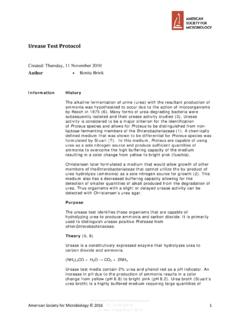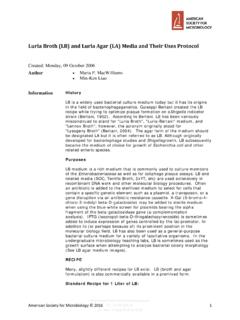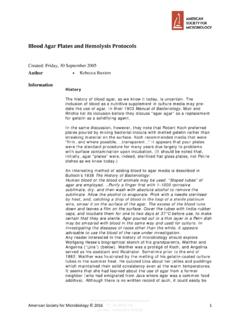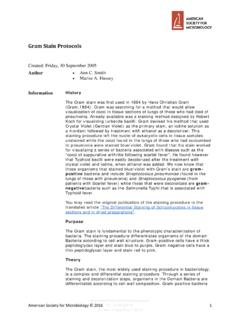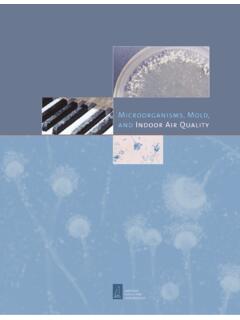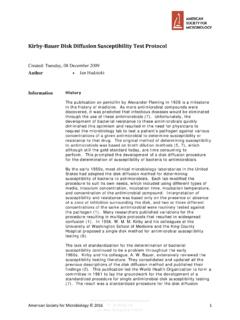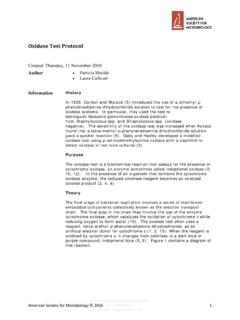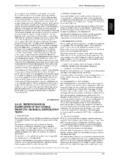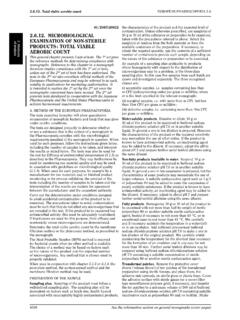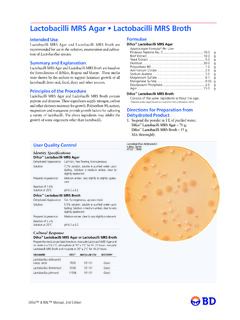Transcription of Indole Test Protocol
1 Downloaded from byIP: : Mon, 12 Aug 2019 20:04:30 American Society for Microbiology 2016 1 Indole Test Protocol | | Created: Tuesday, 08 December 2009 Author Maria P. MacWilliams Information History As far back as 1889, the Indole test was used as a means to distinguish between Escherichia coli andEnterobacter aerogenes (4). The numerous variations of the Indole test alone and in combination with other biochemical tests attest to the central role this test has played in the characterization of coliforms (gram-negative nonsporulating bacilli that ferment lactose, producing acid and gas) (5). The Indole test is still used as a classic test to distinguish Indole -positive E. coli from Indole -negativeEnterobacter and Klebsiella.
2 (8) Purpose The Indole test screens for the ability of an organism to degrade the amino acid tryptophan and produce Indole . It is used as part of the IMViC procedures, a battery of tests designed to distinguish among members of the family Enterobacteriaceae. Theory (3, 5) Tryptophan is an amino acid that can undergo deamination and hydrolysis by bacteria that express tryptophanase enzyme. tryptophan + water = Indole + pyruvic acid + ammonia The chief requirement for culturing an organism prior to performing the Indole test is that the medium contains a sufficient quantity of tryptophan (5). The presence of Indole when a microbe is grown in a medium rich in tryptophan demonstrates that an organism has the capacity to degrade tryptophan.
3 Detection of Indole , a by-product of tryptophan metabolism, relies upon the chemical reaction between Indole and p-dimethylaminobenzaldehyde (DMAB) under acidic conditions to produce the red dye rosindole (5, 8). RECIPES The main requirement for a suitable Indole test medium is that it contain a sufficient amount of tryptophan. Although many media meet this criterion, tryptone broth is commonly used. Downloaded from byIP: : Mon, 12 Aug 2019 20:04:30 American Society for Microbiology 2016 2 Tryptone broth (2) Ingredient Amount Tryptone g Sodium chloride g Dissolve the ingredients in 1 liter of sterile water. Dispense 4 ml per tube. Cap tube and autoclave at 121oC under 15 psi pressure for 15 minutes.
4 Store the tubes in the refrigerator at 4 to 10 C. Kov cs reagent (3, 5) Ingredient Amount Amyl or isoamyl alcohol, reagent grade (butyl alcohol may be substituted) ml p-dimethylaminobenzaldehyde (DMAB) g HCl (concentrated) ml Dissolve DMAB in the alcohol. Gentle heating might be required to get the aldehyde into solution. Slowly add the acid to the aldehyde-alcohol mixture. The solution should be a pale yellow color and is only stable for a short time. Store the mixture in a brown glass bottle in the refrigerator. Kov cs reagent also is commercially available. Protocol Inoculate the tube of tryptone broth with a small amount of a pure culture.
5 Incubate at 35 C (+/- 2 C) for 24 to 48 hours. To test for Indole production, add 5 drops of Kov cs reagent directly to the tube (3, 5). A positive Indole test is indicated by the formation of a pink to red color ("cherry-red ring") in the reagent layer on top of the medium within seconds of adding the reagent (Fig. 1b). If a culture is Indole negative, the reagent layer will remain yellow or be slightly cloudy (Fig. 1c). Downloaded from byIP: : Mon, 12 Aug 2019 20:04:30 American Society for Microbiology 2016 3 (a) (b) (c) FIG 1. The Indole test. (a) An uninoculated tube of tryptone broth. (b) A positive Indole test. The 48-hour Escherichia coli culture grown at 37 C tests positive for the presence of Indole as indicated by the red reagent layer after the addition of Kov cs reagent.
6 (c) A negative Indole test. The 48-hour Enterobacter aerogenes culture incubated at 37 C has not broken down the tryptophan in the medium and thus no color change occurs upon addition of the Kov cs reagent. The reagent appears as a thin yellow layer on top of the culture medium. See Indole Test Atlas images of Indole test using tryptone broth. Alternate Methods of Detecting Indole Production Tryptophan peptone broth Tryptophan peptone broth (1, 5) Ingredients Amount Casein peptone g Sodium chloride g Tryptophana g aThe tryptophan concentration can be varied; the amount used here will result in a 1% final concentration. Downloaded from byIP: : Mon, 12 Aug 2019 20:04:30 American Society for Microbiology 2016 4 Dissolve ingredients in 1 liter of distilled water.
7 Dispense 4 ml per tube. Cap tube and autoclave at 121 C under 15 psi pressure for 15 minutes. Store tubes in the refrigerator at 4 to 10 C. Inoculate, incubate, and perform test as described above for tryptone broth. Sulfide- Indole -motility (SIM) medium (1, 3, 5) The SIM medium is a multitest agar used to test for Indole production while simultaneously determining other characteristics of the bacterium (see Comments and Tips section). SIM medium Ingredients Amount Peptone Beef extract g g g Ferrous ammonium sulfate Sodium thiosulfate g Agar g Dissolve ingredients, except agar, in 1 liter of distilled water. Adjust pH to Add agar and heat mixture to boiling to dissolve agar.
8 Cool to 50 C. Dispense in to ml aliquots in 16-mm test tubes. Cap tubes and autoclave at 121 C under 15 psi pressure for 15 minutes. After autoclaving, allow tubes to cool in an upright position to form the agar deep. Tubes can be stored at 4 to 8 C for several months. SIM medium is commercially available both as a premixed powder and as premade deep tubes. To inoculate SIM medium, pick an isolated colony with a needle. Stab the needle approximately two-thirds of the way into the deep and then remove it following the same path as the entry. Incubate at 35 C (+/-2 C) for 24 to 48 hours or until growth is evident. To test for the presence of Indole , a by-product of tryptophan metabolism, 5 drops of Kov cs reagent should be added to the top of the deep.
9 A positive Indole test is indicated by the formation of a red color in the reagent layer on top of the agar deep within seconds of adding the reagent. If a culture is Indole negative, the reagent layer will remain yellow or be slightly cloudy. Downloaded from byIP: : Mon, 12 Aug 2019 20:04:30 American Society for Microbiology 2016 5 See Indole Atlas images Alternative Methods for Determining Indole Production for SIM result images. Motility- Indole -ornithine (MIO) medium (1, 2) The MIO medium is a multitest agar used to test for Indole production while simultaneously determining other characteristics of the bacterium (see Comments and Tips section). MIO medium Ingredients Amount Yeast extract Peptone g g g Tryptone L-ornithine HCl g Dextrose g Agar g Bromcresol purple g Bring to 1 liter with distilled water.
10 Heat mixture to boiling to dissolve agar. Cool to 50 C. Dispense in to ml aliquots in 16-mm test tubes. Cap tubes and autoclave at 121 C under 15 psi pressure for 15 minutes. After autoclaving, allow tubes to cool in an upright position to form the agar deep. Tubes can be stored at 4 to 8 C for several months. MIO medium is commercially available both as a premixed powder and as premade deep tubes. To inoculate MIO medium, pick an isolated colony with a needle. Stab the needle approximately two-thirds of the way into the deep and then remove it following the same path as the entry. Incubate at 35 C (+/-2 C) for 24 to 48 hours or until growth is evident. To test for the presence of Indole , a by-product of tryptophan metabolism, 5 drops of Kov cs reagent should be added to the top of the deep.
